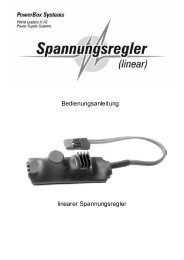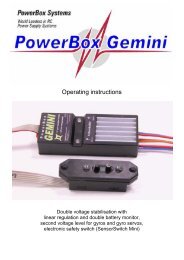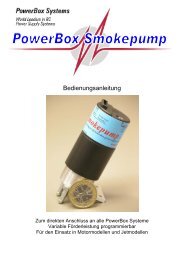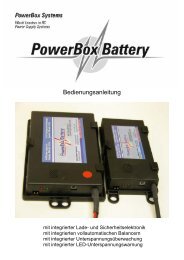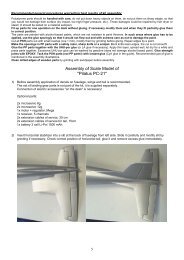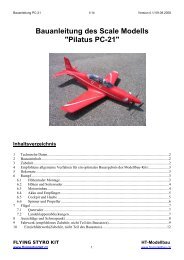Operating Instructions - PowerBox Systems
Operating Instructions - PowerBox Systems
Operating Instructions - PowerBox Systems
Create successful ePaper yourself
Turn your PDF publications into a flip-book with our unique Google optimized e-Paper software.
<strong>PowerBox</strong> Sensor<br />
5. Using the Sensor-Switch<br />
The sensor buttons do not switch the current for the receiver and servos. The actual<br />
switching process is carried out by the two electronic switches in the POWER<br />
BOX Sensor, which are independent of each other.<br />
The controls on the front panel consist of three push-buttons, two green LEDs and<br />
one red LED.<br />
You will find two countersunk holes into which the mounting screws (supplied) fit.<br />
These are used to attach the switch to the model.<br />
The push-buttons are marked “SET” and “I” and “II”.<br />
The purpose of the slightly recessed “SET” button is to prepare and execute a<br />
switching process. Holding the “SET” button pressed in for about one second<br />
“arms” both internal switches, and the red LED lights up. You can now switch either<br />
or both power circuits on by pressing the other push-buttons “I” and “II”. This<br />
method of switching allows you to check each power circuit or battery separately.<br />
To switch off the POWER BOX Sensor, first hold the “SET” button pressed in,<br />
then press the push-buttons “I” and “II” in turn to switch both batteries off again.<br />
This new switching system as our own in-house development, and offers you the<br />
highest possible standard of security.<br />
When the electronic switches are in the “stand-by” state, i.e. the batteries are<br />
switched off, they draw an idle current of about 5 micro-Amps. This corresponds to<br />
a small fraction of the self-discharge rate of normal batteries.<br />
However, if you do not intend to use your model for a long period we recommend<br />
that you disconnect them from the POWER BOX Sensor, especially if you are using<br />
a Lithium-Polymer battery.<br />
The POWER BOX Sensor is virtually impervious to vibration, but it is still good<br />
practice to mount the unit in an area of the model where vibration levels are low.<br />
Please note that the GRP fuselage sides of a power model are not suitable, as they<br />
are always subject to considerable vibration. You can remedy the situation by cutting<br />
a ply plate (2 - 3 mm thick) about 3 cm larger than the switch aperture, and<br />
gluing it in the appropriate position. The plate damps the vibration, and at the same<br />
time provides plenty of “meat” into which the retaining screws of the POWER BOX<br />
Sensor can “bite”.<br />
- 6 -




